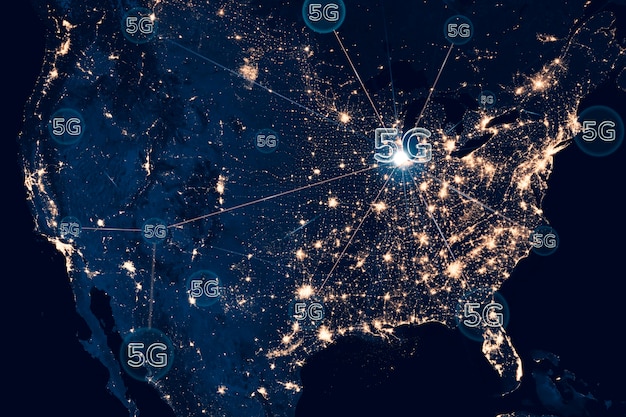The Future of Cloud Gaming: Will 5G Finally Make It Viable in the US?

The viability of cloud gaming in the US hinges significantly on the widespread adoption and consistent performance of 5G technology, which promises to address current latency and bandwidth challenges, potentially transforming the industry.
The landscape of gaming is constantly evolving, with cloud gaming emerging as a transformative force. Yet, a persistent question remains: The Future of Cloud Gaming: Will 5G Finally Make It Viable in the US? This exploration delves into the intricate relationship between advanced network technology and the aspirations of a seamless, accessible gaming experience.
The Cloud Gaming Dream: Promises and Past Pitfalls
Cloud gaming promises a revolutionary shift in how we access and play video games, essentially streaming games directly from remote servers to our devices. This vision liberates players from the need for expensive, high-end hardware, long downloads, and physical media, opening up gaming to a much broader audience. It envisions a world where a casual gamer with a smartphone can jump into the latest AAA title with the same fidelity as a PC enthusiast.
The Allure of Accessibility and Convenience
The primary appeal of cloud gaming lies in its unparalleled accessibility. Imagine being able to play graphically intensive games on a basic laptop, a budget tablet, or even a smart TV, without needing to upgrade components or manage storage space. This democratization of gaming could bring millions of new players into the fold, especially those who cannot afford or justify the cost of dedicated gaming consoles or powerful PCs. Furthermore, the convenience of instantly playing games without lengthy installations or patches is a significant draw, aligning with the “on-demand” nature of modern entertainment consumption.
Past Hurdles: Latency, Bandwidth, and User Experience
Despite these compelling promises, cloud gaming has historically faced substantial hurdles that have hampered its widespread adoption and viability, particularly in markets like the US.
- Latency: The most critical challenge is latency, the delay between a player’s input and the game’s response on screen. In traditional gaming, this delay is negligible. In cloud gaming, inputs travel to a distant server, the server processes the command and renders the new frame, and then that frame streams back to the player’s device. Even milliseconds of delay can turn a fast-paced action game into an unplayable slideshow.
- Bandwidth: High-definition video streams, especially those with minimal compression artifacts, demand substantial bandwidth. To deliver 1080p or 4K gaming experiences, a stable and fast internet connection is crucial. In areas with inconsistent or limited broadband infrastructure, cloud gaming struggles to deliver a reliable experience.
- Image Quality: Compressing and streaming high-fidelity graphics over a network can introduce visual artifacts, blurring, and a general loss of crispness compared to local rendering. This can detract significantly from the immersive experience gamers expect from modern titles.
- Data Caps: Many US internet service providers (ISPs) impose data caps on home connections. Streaming hours of high-definition video games can quickly consume these allowances, leading to overage charges or throttled speeds, making cloud gaming economically unfeasible for some.
These technical limitations have, until now, made the cloud gaming dream feel more like a distant mirage than a tangible reality for many. The question then becomes: can a new technology, like 5G, truly overcome these deeply ingrained challenges? The answer lies in understanding 5G’s unique capabilities and how they directly address these pain points.
5G’s Core Capabilities: A Game Changer?
The advent of 5G technology has been heralded as a paradigm shift in wireless connectivity, promising speeds and responsiveness far exceeding its predecessors. For cloud gaming, these capabilities are not merely incremental improvements; they represent potentially foundational solutions to the very problems that have plagued the sector.
Ultra-Low Latency: The Holy Grail for Cloud Gaming
Among 5G’s most significant advancements, and arguably its most crucial for cloud gaming, is its promise of ultra-low latency. While 4G LTE typically offers latencies in the range of 50-100 milliseconds, 5G aims to bring this down to as low as 1 millisecond (ms) in ideal conditions, especially with the deployment of network slicing and mobile edge computing (MEC).
- Milliseconds Matter: In competitive online gaming, every millisecond counts. A delay of even 50ms can feel noticeable in a first-person shooter or fighting game, leading to missed shots or unresponsive controls. Reducing this to single-digit milliseconds significantly narrows the gap between local and cloud-streamed game experiences, making input lag virtually imperceptible for most players.
- Edge Computing Synergy: The synergy between 5G and mobile edge computing further reduces latency. Instead of game servers being housed in distant data centers, MEC allows them to be physically closer to the end-user – often at the base of 5G cell towers. This drastically shortens the physical distance data needs to travel, cutting down on round-trip times and enhancing responsiveness. It’s a fundamental architectural shift that aligns perfectly with the demands of interactive real-time applications like gaming.
Massive Bandwidth and Throughput: Unlocking Visual Fidelity
Beyond latency, 5G boasts significantly higher bandwidth and throughput compared to 4G. While 4G might offer peak speeds of a few hundred megabits per second (Mbps), 5G can deliver multi-gigabit per second (Gbps) speeds, particularly over millimeter-wave (mmWave) frequencies.
- Higher Resolution Streams: More bandwidth means the ability to stream higher-resolution video (1080p, 4K, or even 8K) with less compression. This translates directly to sharper images, richer colors, and a more immersive visual experience, bridging the gap between streaming quality and native rendering.
- Consistent Performance: Moreover, 5G’s capacity to handle numerous concurrent connections without significant degradation in performance means that even in densely populated areas or peak usage times, the network can maintain stable, high-speed connections for cloud gaming. This consistency is vital for a smooth, uninterrupted gaming session, addressing the common frustration of stuttering or resolution drops.
Network Slicing: Dedicated Resources for Gamers
Network slicing is a less talked about but equally transformative feature of 5G. It allows network operators to create virtual, isolated slices of the network, each optimized for specific services. For cloud gaming, this means:
- Prioritized Traffic: A dedicated network slice could be provisioned specifically for cloud gaming traffic, guaranteeing a certain level of latency, bandwidth, and reliability, even if other network traffic (like general web browsing or video streaming) is congested.
- Tailored QoS (Quality of Service): This capability would empower cloud gaming providers to negotiate specific Quality of Service agreements with network operators, ensuring that their game streams receive the necessary priority and resources to deliver a premium experience, akin to having a private fast lane on the internet highway.
These core advancements position 5G as a strong contender to reshape the viability of cloud gaming. However, the promise of the technology must contend with the realities of its rollout and adoption.
The Current State of 5G Deployment in the US
While 5G’s potential for cloud gaming is significant, its real-world impact is heavily dependent on the extent and nature of its deployment. In the US, the 5G rollout has been multifaceted, characterized by varying speeds, coverage, and spectrum usage. The current state is a patchwork of technologies, each with its own advantages and limitations for data-intensive applications like cloud gaming.
Different Flavors of 5G: Sub-6, C-band, and mmWave
Not all 5G is created equal. US carriers are deploying 5G across a range of spectrum frequencies, each offering different trade-offs:
- Low-band (Sub-6 GHz): This is the widest-reaching 5G, offering coverage similar to 4G LTE. While it provides better speeds than 4G, its latency benefits are less pronounced, and peak speeds typically range from 100-300 Mbps. For cloud gaming, this offers an improvement but might not be the game-changer required for truly seamless 4K experiences. It’s good for basic cloud gaming, but not optimal for competitive or high-fidelity play.
- Mid-band (C-band): The C-band spectrum, a significant portion of which was recently auctioned off and cleared, offers a sweet spot. It provides a good balance of speed (300-800 Mbps, sometimes exceeding 1 Gbps) and coverage. Crucially, C-band 5G brings lower latency closer to the theoretical 5G capabilities. This is where cloud gaming really starts to shine for many users, offering a noticeably better experience. Adoption of C-band is rapidly expanding across major urban and suburban areas.
- High-band (millimeter-wave or mmWave): This is the “super-fast” 5G often seen in promotional materials, offering multi-gigabit speeds (up to 4-5 Gbps) and ultra-low latency. However, mmWave signals have extremely limited range and struggle to penetrate obstacles like walls, making its deployment largely confined to dense urban centers, stadiums, and specific outdoor “hotspots.” While offering the ideal conditions for cloud gaming, its limited availability means it’s not a widespread solution for ubiquitous access.
The US market is seeing rapid expansion of mid-band 5G, which is the key driver for enhancing cloud gaming experiences for the broader population. Low-band acts as a foundational layer, while mmWave targets niche, high-density areas.

Coverage and Consistency: Beyond Speed Tests
While carriers often highlight peak speeds, the reality for cloud gaming users is about consistent performance. A 5G connection might show impressive download speeds in a speed test, but maintaining that performance during an intense gaming session, especially with low latency, is another matter.
- Geographical Disparities: 5G coverage remains highly uneven across the US. Major metropolitan areas generally have good access to mid-band and some mmWave, but rural and even many suburban areas still largely rely on low-band 5G or even 4G. This disparity creates a significant hurdle for cloud gaming providers aiming for nationwide viability.
- Indoor vs. Outdoor Performance: The performance of 5G, particularly mid-band and mmWave, can vary significantly between outdoor and indoor environments. Walls, building materials, and even foliage can attenuate signals, reducing speed and increasing latency. This means a user might have a great experience playing on their porch but a subpar one in their living room.
The current state of 5G in the US suggests that while the technology has immense potential, its full realization for cloud gaming is still a work in progress. Widespread, consistent, and low-latency 5G experiences are not yet a universal given, which limits truly transformative shifts in gaming habits.
Cloud Gaming Platforms: Readiness and Integration
The viability of cloud gaming via 5G isn’t solely dependent on network infrastructure; it also relies heavily on the capabilities and integration strategies of the cloud gaming platforms themselves. Major players like Xbox Cloud Gaming, GeForce NOW, and PlayStation Plus Premium are constantly evolving, adapting their technology to leverage new network advancements, including 5G.
Major Players and Their Approaches
Each cloud gaming platform brings its own strengths, content libraries, and technical approaches to the table, impacting how effectively they can capitalize on 5G:
- Xbox Cloud Gaming (Microsoft): As part of Xbox Game Pass Ultimate, Microsoft’s offering boasts a vast library of first-party Xbox titles and numerous third-party games. Xbox Cloud Gaming primarily runs on custom Xbox Series X hardware in Microsoft’s Azure data centers. Their strategy is to create a seamless extension of the Xbox ecosystem, allowing existing subscribers to play across devices. They have invested heavily in edge computing and optimizing their streaming protocols to reduce latency, making them well-positioned to benefit from 5G’s lower latencies.
- GeForce NOW (NVIDIA): NVIDIA’s platform streams games directly from PC-grade graphics cards housed in their data centers. This allows players to access their existing PC game libraries from storefronts like Steam and Epic Games Store, offering a wide array of titles. GeForce NOW focuses on delivering high-fidelity PC gaming experiences, often at 1080p or 1440p, with high frame rates. This demands significant bandwidth and consistent low latency, making 5G crucial for achieving its full potential. NVIDIA’s approach is hardware-centric, aiming to provide the raw power needed for demanding games.
- PlayStation Plus Premium (Sony): Sony’s cloud gaming component, leveraging technology from PlayStation Now, primarily streams PS3, PS4, and some PS5 games. While their library is extensive, the streaming quality and performance have historically been a point of critique. Sony’s challenge is to upgrade its streaming infrastructure to match the demands of modern gamers and fully exploit 5G capabilities to reduce latency and improve visual quality, especially for newer titles.
- Amazon Luna: Amazon’s entry into cloud gaming, integrated with Prime, offers specific channels and a growing library. Luna benefits from Amazon’s extensive AWS cloud infrastructure, potentially allowing for wide geographic distribution of servers, which can help in reducing latency by being closer to end-users. Its integration with Twitch also provides unique possibilities for shared experiences.
Optimizing for the 5G Environment
Cloud gaming platforms must continuously optimize their software and infrastructure to fully harness 5G’s potential. This involves several key areas:
- Adaptive Bitrate Streaming: All major platforms utilize adaptive bitrate streaming, which dynamically adjusts stream quality based on available bandwidth. With 5G, this allows the stream to consistently push higher resolutions and frame rates. However, the responsiveness of this adaptation is key for a seamless experience.
- Codec Efficiency: Employing advanced video codecs (like AV1, H.265/HEVC) that offer better compression efficiency at lower latency is crucial. More efficient codecs mean higher quality streams can be delivered over less bandwidth, or the same quality can be maintained with less strain on the network.
- Edge Server Proximity: Platforms are increasingly deploying game servers at the “edge” of the network, closer to populated areas, often co-located with 5G infrastructure. This significantly reduces the physical distance data has to travel, directly impacting latency. Microsoft’s Azure regions and NVIDIA’s distributed data centers are examples of this strategic placement.
- Input Latency Reduction: Beyond network latency, platforms are also working to minimize input processing latency on the server side and decoding latency on the client device. This involves highly optimized software stacks and efficient hardware utilization.
The readiness of these platforms to fully integrate with and exploit 5G’s advances will be critical in shaping the future of cloud gaming. Early adopters of 5G-optimized solutions will likely gain a significant competitive edge, proving that the technology and the service must evolve hand-in-hand.

Challenges Beyond 5G: The Ecosystem Remains Complex
While 5G addresses many of cloud gaming’s core technical challenges, its advent doesn’t magically solve all hurdles. The broader ecosystem, encompassing consumer behavior, economic models, and regulatory landscapes, presents its own set of complexities that will profoundly influence the viability of cloud gaming in the US.
Consumer Adoption and Awareness
Even with lightning-fast 5G, persuading a mass market to embrace cloud gaming requires significant effort.
- Habit Formation: Gamers, particularly console and PC enthusiasts, have deeply ingrained habits of owning hardware and local game copies. Shifting this paradigm requires a compelling value proposition and a flawless user experience to overcome inertia.
- Perception vs. Reality: Many early attempts at cloud gaming left a poor impression due to performance issues. Overcoming these lingering perceptions, even with improved 5G, will require extensive marketing and consistent, positive user experiences to rebuild trust. Consumers need to be convinced that cloud gaming, powered by 5G, is now genuinely good.
- Awareness & Education: The intricacies of 5G (sub-6, C-band, mmWave) are not widely understood by the average consumer. Clearly communicating the benefits of the right kind of 5G for cloud gaming will be crucial.
Economic Realities: Data Caps and Subscription Fatigue
The economic models surrounding 5G and cloud gaming introduce their own set of challenges:
- Persistent Data Caps: While 5G offers higher speeds, many home internet plans in the US still have data caps. Streaming hours of 4K games could quickly exhaust these limits. Mobile 5G plans often have “unlimited” data that throttles after a certain usage threshold, which could impact gaming performance. Unless ISPs adjust their data policies for cloud gaming, it could remain economically unattractive for heavy users.
- Subscription Saturation: Consumers are already facing numerous subscription services for video, music, and various apps. Adding another gaming subscription, on top of potentially higher 5G mobile plan costs, could lead to “subscription fatigue,” where consumers become selective about what they pay for.
- Hardware vs. Subscription Cost: The promise of not needing expensive hardware is appealing, but constant subscription fees can add up over time, especially for multiple services. The long-term cost-benefit analysis will be a critical factor for many consumers.
Device Ecosystem and Input Lag Beyond the Network
While 5G addresses network latency, other forms of latency in the device ecosystem still exist:
- Display Latency: The time it takes for a display to process and show an image can vary. TVs and monitors with high input lag can negate some of 5G’s benefits.
- Controller Latency: Bluetooth controllers, while convenient, inherently introduce a small amount of latency. Wired connections typically offer lower latency, but this goes against the wireless convenience promised by cloud gaming.
- Decoding Latency: The client device’s ability to quickly decode the incoming video stream is also a factor. Older or less powerful devices might introduce decoding delays.
Cloud gaming’s viability in the US is a multifaceted equation. 5G is a powerful variable, but it does not exist in a vacuum. Consumer willingness, economic practicality, and optimizations across the entire hardware and software stack will collectively determine whether the cloud gaming dream becomes a widespread reality.
The Impact of Mobile Edge Computing (MEC)
Mobile Edge Computing (MEC), often discussed in conjunction with 5G, is not just an incremental improvement; it’s a fundamental architectural shift that could significantly accelerate the viability of cloud gaming. By bringing computing resources closer to the user, MEC directly tackles the latency challenge in a way that centralized data centers cannot, regardless of network speed.
Reducing the Physical Distance of Computation
Traditional cloud computing relies on large, centralized data centers that might be hundreds or even thousands of miles away from the end-user. While optic fiber provides incredible speed, distance still equates to latency. Light takes time to travel, and every mile adds milliseconds to the round-trip time.
- Decentralized Servers: MEC involves deploying mini-data centers or computing nodes at the “edge” of the network – typically at cell tower sites, metropolitan data exchanges, or even within telco central offices. These edge servers are geographically much closer to where the majority of 5G users are located.
- Lower Latency: When a cloud gaming application leverages MEC, the game server instance can run on an edge server perhaps only 10-20 miles away, instead of 1000 miles. This drastically reduces the physical distance data has to travel, cutting down network latency to single-digit milliseconds, approaching the responsiveness of local gaming. This is perhaps the most crucial technical advantage MEC offers for real-time interactive applications like gaming.
Enhanced Bandwidth and Reduced Congestion
MEC also contributes to better bandwidth utilization and reduced network congestion.
- Local Traffic Offload: By processing and rendering game streams at the edge, less data needs to be backhauled to core data centers. This offloads significant traffic from the main internet backbone, freeing up bandwidth for other services and reducing overall network congestion.
- Localized Processing: For cloud gaming, this means the high-bandwidth video stream is generated and consumed locally, effectively creating a dedicated, high-speed pipe between the edge server and the user’s 5G device, ensuring more consistent performance, even during peak network times.
Opportunities for Innovation and New Experiences
Beyond simply making existing games playable, MEC combined with 5G opens up new possibilities for cloud gaming experiences:
- Hyper-Personalized Gaming: With computational power closer to the user, it might enable more personalized, dynamically generated game content or AI-driven experiences that react instantly to player input and environment.
- Massive Multiplayer Experiences: The ability to host game sessions on edge servers significantly reduces the latency between players in a local geographic area. This could create ultra-responsive multiplayer experiences for large groups of players, potentially fostering localized esports or social gaming events with minimal lag between participants.
- Augmented Reality (AR) & Virtual Reality (VR) Integration: The ultra-low latency and high bandwidth of 5G and MEC are foundational for untethered, high-fidelity AR/VR experiences. Cloud-rendered AR/VR games could be streamed to headsets without significant discomfort due to lag, blending virtual elements seamlessly into the real world.
The strategic deployment of MEC in the US, alongside the expansion of 5G, is a critical piece of the puzzle for cloud gaming’s long-term viability. It transforms 5G from just a faster pipe into an intelligent, distributed computing platform that can truly deliver on the promise of immersive, responsive cloud gaming.
Looking Ahead: The Road to Ubiquitous Cloud Gaming
The trajectory for cloud gaming in the US, significantly influenced by 5G, points towards a future of increasing viability, though not without ongoing evolution. The path to ubiquitous cloud gaming is paved with continued technological advancements, strategic partnerships, and a keen understanding of evolving consumer demands.
Continued 5G Evolution and Edge Computing Expansion
The underlying network infrastructure will undeniably continue to improve.
- C-band Dominance: Mid-band (C-band) 5G will continue its rapid expansion, becoming the de facto standard for broad, reliable, and high-performance 5G coverage across most populated areas in the US. This will provide the foundation for consistent cloud gaming experiences for the majority.
- mmWave Strategic Gaps: While mmWave deployments will likely remain localized, their strategic placement in high-traffic zones will cater to specific, premium cloud gaming experiences in highly dense areas.
- Deeper MEC Integration: Carriers and cloud providers will continue to roll out more edge computing nodes, moving game servers even closer to the end-user. This densification of edge infrastructure is paramount for pushing latency to near-imperceptible levels.
Smarter Streaming and Hardware Optimizations
Cloud gaming platforms themselves will become more sophisticated:
- Advanced Codecs: Further research and adoption of next-generation video codecs will allow for even higher visual quality at lower bitrates, making cloud gaming more forgiving on existing networks and enabling stunning visuals on 5G.
- AI-Powered Optimizations: Artificial intelligence and machine learning will be increasingly used to predict network conditions, optimize streaming parameters in real-time, and even anticipate player inputs to proactively reduce perceived latency.
- Client-Side Improvements: Gaming devices, from smart TVs to mobile phones, will incorporate dedicated hardware more adept at decoding cloud game streams with minimal latency, closing the gap between network and display lag.
Shifting Consumer Expectations and Business Models
As the technology matures, consumer preferences and the economic landscape will also adapt:
- Hybrid Models: Expect more hybrid business models, combining subscription services with options for individual game purchases or even day passes for premium titles. This flexibility could appeal to a wider range of gamers.
- Device Agnosticism: The true promise of cloud gaming is playing anywhere, on any screen. As technology improves, users will expect a seamless experience moving between their phone, tablet, laptop, and smart TV, often mid-game.
- The “Netflix of Gaming” Realized: As the technological bottlenecks are removed, cloud gaming platforms could truly become the “Netflix of gaming,” where a vast library of high-quality games is instantly accessible, driving mass adoption amongst casual and core gamers alike.
The future of cloud gaming in the US is bright, primarily because 5G, particularly its mid-band and MEC components, directly addresses the historical pain points of latency and bandwidth. While challenges remain, the clear trajectory is towards a future where cloud gaming is not just viable, but a primary, widespread method of playing games for millions of Americans, transforming the industry as we know it.
| Key Aspect | Brief Description |
|---|---|
| 🚀 Latency Reduction | 5G’s ultra-low latency (especially with MEC) is critical for responsive, real-time cloud gaming, significantly reducing input lag. |
| ⚡️ Bandwidth Boost | High 5G bandwidth enables seamless streaming of high-resolution (4K+) game visuals with minimal compression artifacts. |
| 📍 Edge Computing | MEC brings game servers closer to users, drastically cutting data travel distance and enhancing responsiveness for cloud titles. |
| 💰 Economic Hurdles | Data caps and subscription fatigue remain significant challenges for widespread cloud gaming adoption, even with 5G. |
Frequently Asked Questions about 5G and Cloud Gaming
▼
Cloud gaming, often called game streaming, allows you to play video games remotely over the internet. Instead of installing games on your local device, the game runs on powerful servers in data centers, and the gameplay video is streamed to your device, while your inputs are sent back to the server. This means you don’t need expensive hardware to play the latest games.
▼
5G primarily helps cloud gaming by significantly reducing latency and increasing bandwidth. Ultra-low latency ensures that your button presses are registered almost instantly by the remote server, while higher bandwidth allows for streaming of higher resolution and more visually rich game experiences. It addresses the two biggest technical roadblocks for cloud gaming.
▼
Latency is the delay between your action (like pressing a button) and the game’s reaction on your screen. In cloud gaming, this involves sending your input to a server, the server processing it, and the resulting video frame streaming back. High latency results in noticeable lag, making games feel unresponsive and frustrating. 5G aims to bring this delay down to barely perceptible levels.
▼
No, not all 5G is the same. Mid-band (C-band) and high-band (mmWave) 5G offer the best performance for cloud gaming due to their superior speed and lower latency compared to low-band 5G. Mid-band provides a good balance of coverage and performance, making it the most impactful for widespread cloud gaming viability in the US.
▼
Even with 5G, challenges for cloud gaming include persistent data caps from ISPs, consumer perception issues from past failures, subscription fatigue given the numerous streaming services, and optimizing latency from the gaming device and display itself. The full ecosystem needs to mature for truly widespread adoption.
Conclusion
The journey of cloud gaming towards widespread viability in the US is inextricably linked with the evolution of 5G technology. While the dream of playing any game, anywhere, on any device has long captivated the imagination, traditional network limitations have kept it largely out of reach for a mass audience. 5G, with its foundational improvements in low latency and high bandwidth, coupled with the strategic implementation of mobile edge computing, directly addresses these historical barriers. As 5G continues its robust deployment, particularly in the critical mid-band spectrum, and cloud gaming platforms ceaselessly optimize their streaming technologies, the landscape is poised for a significant transformation. While challenges related to consumer habits, data caps, and the broader economic ecosystem still exist, the overwhelming technical synergy between 5G and cloud gaming offers a compelling vision for the future, strongly suggesting that the once-elusive promise of seamless, accessible gaming for all is finally within reach in the US.





